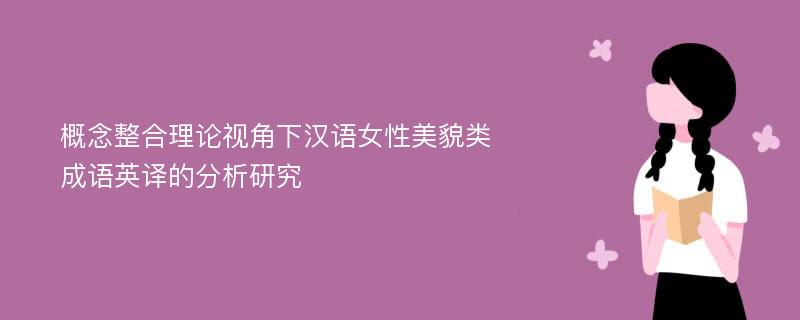
论文摘要
成语是一个民族语言宝库中的精华,有着浓郁的民族特色,独特的语言魅力以及深厚的文化内涵。在中华民族浩瀚的成语使用史中,有一部分成语被用来描绘女性的美貌,他们为数不多,却体现了古代中国人丰富的审美体验以及汉语语言强大的美学表现力。随着全球化进程的加速,跨文化交际已成为现代社会人类生活不可或缺的一部分,作为跨文化交际的重要途径之一,翻译研究吸引了越来越多的学者的关注。传统的翻译观往往把意义看作是在源语语篇(source text)和目的语语篇(target text)之间进行传递的客观存在,力求在不同的文化背景下找到完全相同的语言描述。这些观点一方面忽视了翻译本身是一个动态的,由多种因素共同制约的过程,另一方面对翻译者作为翻译主体的主观认知性没有系统地涉及。随着认知科学的发展,特别是在Fauconnier&Turner(1994,1998)的概念整合理论提出之后,译者的主观性开始受到了广泛的关注,翻译逐渐被看作是一个由四个空间相互作用的过程,即两个输入空间(原文空间和译者空间)在类属空间的映射下在整合空间(译文空间)中的概念整合过程。其中译者首先在原文语境对原文作者意欲传达的概念结构与原文语法进行解构整合,然后在目的语语境下结合自己的语言能力、语用考虑、个人偏好及认知语境(其中包括已内化为译者认知语境一部分的目的与语法),对该概念结构进行再次整合,最终形成译文文本。值得注意的是,一些优化原则,如整合原则、拓扑原则、网络原则等对整个概念整合过程起到制约的作用。理论研究的生命力取决于其在实践中的应用。本文将运用概念整合理论对汉语女性美貌类成语英译的认知过程进行分析,一方面旨在对概念整合理论的阐释力进行检验,另一方面,希望通过对译例的分析,为美貌类成语的翻译过程提供一个科学统一的框架模式,以期把中国传统美学观及丰富多彩的审美体验更完善地传达给英语读者。根据概念整合理论的基本思想,笔者将汉语女性美貌类成语的英译过程视为译者在汉语语境下解构(整合)由多个输入空间构成的原成语文本,然后在英语语境下结合自身的主观性,把汉语认知概念结构重新整合到最终的英语翻译的结果。其中第二次整合过程根据汉英语言中认知联系的对应性,可以分为框架整合、单边整合及双边整合三种形式。论文最后,笔者通过对汉语美貌类成语英译概念整合分析做出系统性的总结,结论是翻译工作者从中能够得到一些应用性启示。虽然概念整合理论已被很多学者从不同角度运用到翻译实践中,但与汉语成语的英译,特别是体现了中华民族特有的审美情趣的女性美貌类成语的英译研究却寥寥无几,笔者希望通过本文的探索对细化语言翻译领域的应用有所裨益。
论文目录
Abstract摘要AcknowledgementChapter One Introduction1.1 Background and Significance of the Present Study1.2 Research Question1.3 Layout of the ThesisChapter Two Literature Review Relative to the Present Study2.1 General Introduction to Conceptual Integration Theory2.1.1 Emergence of the Theory2.1.2 Conceptual Integration Networks(CINs)2.1.2.1 The Network Model of Conceptual Integration2.1.2.2 Types of Integration Networks2.1.2.3 Optimality Principles2.1.3 Present Study Scope of Conceptual Integration Theory2.2 Translation through Conceptual Integration2.2.1 Related study2.2.2 Operation Model of Conceptual Integrating during the Translation Process2.2.2.1 Input Space:STS and TRS2.2.2.2 Genetic Space:Similarities in Grammatical and Conceptual Structure2.2.2.3 Blended Space:TTS2.2.2.4 Translator's AgencyChapter Three Understanding Chinese Idioms Describing Female Beauty3.1 Cultural Background of Chinese Idioms of Beauty3.1.1 Gender and Sex3.1.2 Beauty in Ancient Chinese Culture3.1.3 Western Views on Chinese Beauty3.2 Definition of Chinese Idioms for Beauty3.2.1 General Definition of Chinese Idioms3.2.2 Defining Chinese Idioms Describing Female Beauty3.3 The Features of Chinese Idioms Describing Female Beauty3.3.1 Structural Property3.3.2 Semantic Integrity3.3.3 Phonologic Beauty3.3.4 Metaphorical and Metonymical PriorityChapter Four Analyzing the Translation of Chinese Idioms Describing Female Beauty through the Conceptual Integration Theory4.1 CINs Applied in Practical Translation4.1.1 De-integration Operation:STS to TRS4.1.1.1 The De-integration of Literal Meaning4.1.1.2 The De-integration of Associative Meaning4.1.2 Re-blending Operation:TRS to TTS4.1.2.1 Fully-corresponded:Frame networks4.1.2.2 Semi-corresponded:one-side networks and two-side networks4.2 Applicative Implication for TranslatorsChapter Five Conclusion5.1 Major Findings5.2 LimitationsBibliography
相关论文文献
标签:概念整合理论论文; 认知过程论文; 汉语女性美貌类成语论文; 英语翻译论文;
概念整合理论视角下汉语女性美貌类成语英译的分析研究
下载Doc文档
